Rock properties prediction, categorization, and recognition from NMR echo-trains using linear and nonlinear regression
a technology of nmr echotrain and rock properties, applied in the field of nmr apparatus and methods, can solve the problems of inability to establish complex relationships between porous rocks and fluids filling their pore spaces, information loss, and inability to model complex relationships
- Summary
- Abstract
- Description
- Claims
- Application Information
AI Technical Summary
Benefits of technology
Problems solved by technology
Method used
Image
Examples
Embodiment Construction
[0034] An NMR well logging apparatus which is suitable for use with this invention is described, for example, in U.S. Pat. No. 6,247,542 to Kruspe et al., the contents of which are fully incorporated herein by reference. The device in Kruspe is for exemplary purposes only and the method of the present invention may be used with any NMR well logging apparatus including one conveyed on a wireline. As taught by Kruspe, the NMR sensor assembly is slidably coupled to the longitudinal member wherein the sensor assembly includes at least one sensor for obtaining measurements relating to the parameter of interest. When the sensor assembly is held in a non-rotating position, for instance, for obtaining the measurements, the longitudinal member is free to rotate and continue drilling the borehole. The sensor assembly is slidably coupled to the longitudinal member using, for example, at least one guide sleeve slidably coupled to the longitudinal member. The sensor assembly further includes, fo...
PUM
 Login to View More
Login to View More Abstract
Description
Claims
Application Information
 Login to View More
Login to View More - R&D
- Intellectual Property
- Life Sciences
- Materials
- Tech Scout
- Unparalleled Data Quality
- Higher Quality Content
- 60% Fewer Hallucinations
Browse by: Latest US Patents, China's latest patents, Technical Efficacy Thesaurus, Application Domain, Technology Topic, Popular Technical Reports.
© 2025 PatSnap. All rights reserved.Legal|Privacy policy|Modern Slavery Act Transparency Statement|Sitemap|About US| Contact US: help@patsnap.com



